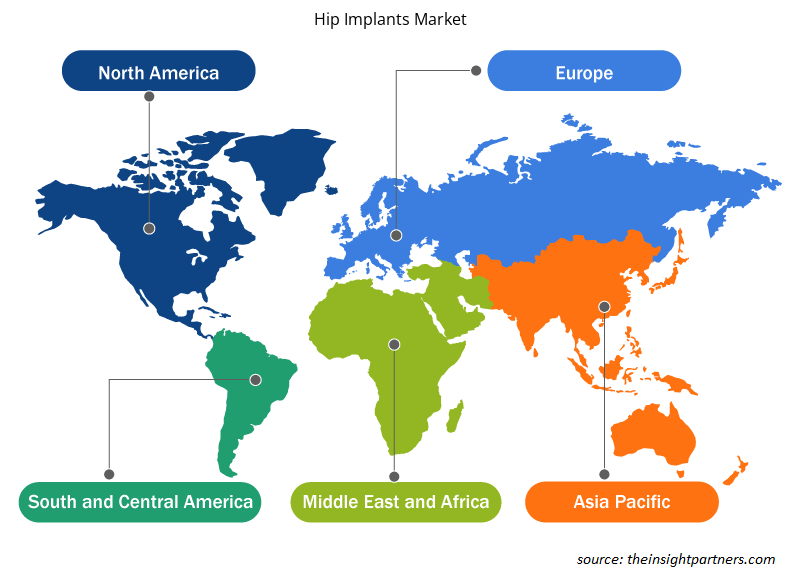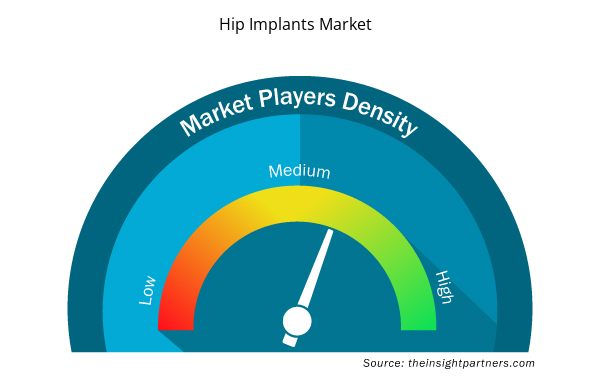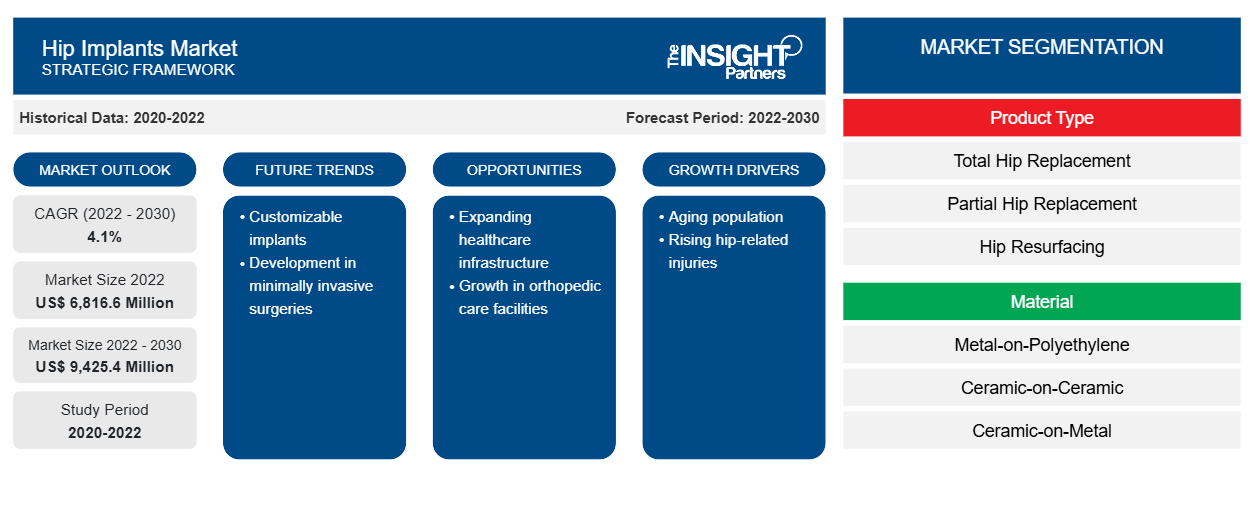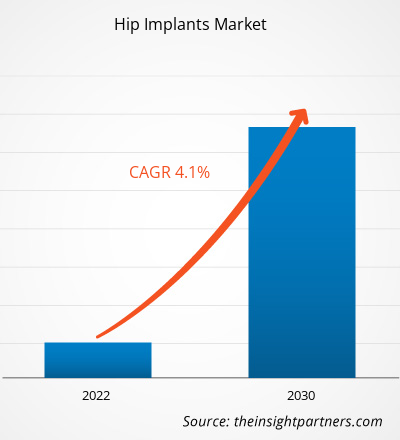[Forschungsbericht] Der Markt für Hüftimplantate soll von 6.816,6 Millionen US-Dollar im Jahr 2022 auf 9.425,4 Millionen US-Dollar im Jahr 2030 wachsen; von 2022 bis 2030 wird eine durchschnittliche jährliche Wachstumsrate (CAGR) von 4,1 % erwartet.
Markteinblicke und Analystenansichten:
Der Markt für Hüftimplantate wächst aufgrund der Zunahme von Hüftoperationen, Hüftverletzungen, Osteoarthritis und rheumatoider Arthritis rasant. Darüber hinaus treiben strategische Initiativen von Unternehmen zur Erhaltung ihrer Wettbewerbsfähigkeit das Wachstum des Marktes voran. So brachte Smith & Nephew im August 2023 in Indien das OR3O Dual Mobility System für primäre und Revisions-Hüftendoprothetik auf den Markt. OR3O enthält Smith & Nephews fortschrittliche Lageroberfläche OXINIUM DH aufgrund seiner Auskleidung und des proprietären OXINIUM auf XLPE. Dadurch werden sowohl die modulare CoCr-Auskleidung als auch die CoCr-Kopfkugel aus der Konstruktion eliminiert, was die mit der Legierung verbundenen Verschleiß- und Korrosionsrisiken verringert. Daher wird ein deutlicher Anstieg revolutionärer Technologien zur Erfüllung der Kundenbedürfnisse wahrscheinlich neue Trends in der Marktprognose für Hüftimplantate mit sich bringen.
Wachstumstreiber und Herausforderungen:
Laut der Osteoarthritis Action Alliance ist Osteoarthritis eine der häufigsten Formen von Arthritis in den USA. Sie betrifft fast 32,5 Millionen Menschen, von denen im Jahr 2020 43 % der Bevölkerung über 65 Jahre alt waren. Laut den Centers for Disease Control and Prevention litten im Jahr 2020 etwa 23 % der US-Bevölkerung an Arthritis. Laut Arthritis Research Canada leiden schätzungsweise über 6 Millionen Kanadier an Osteoarthritis. Bis 2040 sollen es 10,5 Millionen sein. Osteoarthritis kann zu Hüftverletzungen und Hüftfrakturen führen, da die Knochendichte bei Arthritispatienten geringer ist als bei Menschen ohne Arthritis.
Die Weltgesundheitsorganisation (WHO) schätzte die Bevölkerung im Alter von über 60 Jahren im Jahr 2019 auf 1 Milliarde. Bis 2030 soll sie auf 1,4 Milliarden und bis 2050 auf 2,1 Milliarden ansteigen. Der Anteil der geriatrischen Bevölkerung soll in diesem Zeitraum von ~15 % auf ~24 % steigen. Einem anderen Bericht von Eurostat zufolge hatte Europa im Jahr 2021 den weltweit höchsten Anteil (20,8 %) an Menschen über 60 Jahren. Darüber hinaus werden bis 2050 in allen Regionen außer Afrika mehr als 25 % ihrer Bevölkerung die 60 Jahre überschritten haben. Der Anstieg der geriatrischen Bevölkerung hat also die Prävalenz verschiedener orthopädischer Erkrankungen wie Hüftverletzungen, Osteoarthritis und Hüftluxation aufgrund von Stürzen und anderen unglücklichen Vorfällen erhöht, was zu einem Wachstum des Marktes für Hüftimplantate geführt hat.
Passen Sie diesen Bericht Ihren Anforderungen an
Sie erhalten kostenlose Anpassungen an jedem Bericht, einschließlich Teilen dieses Berichts oder einer Analyse auf Länderebene, eines Excel-Datenpakets sowie tolle Angebote und Rabatte für Start-ups und Universitäten.
- Holen Sie sich die wichtigsten Markttrends aus diesem Bericht.Dieses KOSTENLOSE Beispiel umfasst eine Datenanalyse von Markttrends bis hin zu Schätzungen und Prognosen.
Berichtssegmentierung und -umfang:
Der Markt für Hüftimplantate ist nach Produkttyp, Material, Endverbraucher und Geografie unterteilt. Nach Produkttyp ist der Markt in Totalersatz, Teilersatz, Hüftgelenksersatz und Revisions-Hüftimplantate unterteilt. Nach Material ist der Markt in Metall-auf-Polyethylen, Keramik-auf-Keramik, Keramik-auf-Metall, Keramik-auf-Polyethylen und andere unterteilt. Nach Endverbraucher ist der Markt in Krankenhäuser, orthopädische Kliniken, ambulante chirurgische Zentren und andere unterteilt. Nach Geografie ist der Markt in Nordamerika (USA, Kanada und Mexiko), Europa (Großbritannien, Deutschland, Frankreich, Italien, Spanien, Russland und der Rest von Europa), Asien-Pazifik (China, Japan, Indien, Südkorea, Australien und der Rest von Asien-Pazifik), den Nahen Osten und Afrika (die Vereinigten Arabischen Emirate, Saudi-Arabien, Südafrika und der Rest von Nahem Osten und Afrika) und Süd- und Mittelamerika (Brasilien, Argentinien und der Rest von Süd- und Mittelamerika) unterteilt.
Segmentanalyse:
Die Marktanalyse für Hüftimplantate ist nach Produkttyp in Femurrekonstruktion, Acetabulumrekonstruktion, Hüftgelenksersatz, Revisions-Hüftimplantate, Lager- und poröse Metalltechnologien sowie Totalersatzimplantate unterteilt. Im Jahr 2022 hatte das Segment der Totalersatzimplantate den größten Marktanteil bei Hüftimplantaten und wird voraussichtlich zwischen 2022 und 2030 die höchste durchschnittliche jährliche Wachstumsrate verzeichnen.
Nach Material ist der Markt in Metall-auf-Polyethylen, Keramik-auf-Keramik, Keramik-auf-Metall und Keramik-auf-Polyethylen segmentiert. Im Jahr 2022 hatte das Segment Metall-auf-Kunststoff den größten Marktanteil bei Hüftimplantaten und wird voraussichtlich von 2022 bis 2030 die höchste CAGR in der Marktprognose für Hüftimplantate verzeichnen. Das Segmentwachstum wird durch Vorteile wie präzise Ergebnisse, Haltbarkeit und Kosteneffizienz vorangetrieben. Darüber hinaus treiben andere Vorteile wie weniger Komplikationen, technologische Fortschritte und weniger Verschleißpartikel die Nachfrage nach Hüftimplantaten auf Metall-auf-Kunststoff-Basis an.
Nach Endverbraucher ist der Markt in Krankenhäuser, orthopädische Kliniken, ambulante chirurgische Zentren und andere unterteilt. Im Jahr 2022 hatte das Krankenhaussegment den größten Marktanteil bei Hüftimplantaten und wird voraussichtlich zwischen 2022 und 2030 die höchste durchschnittliche jährliche Wachstumsrate verzeichnen. Die steigende Zahl von Operationen für Hüftimplantate in Krankenhäusern treibt das Wachstum des Segments Hüftimplantate weltweit voran. Darüber hinaus ist das Krankenhauspersonal gut ausgebildet und sich der Komplikationen bewusst, die während oder nach einer Operation auftreten können. Das Krankenhauspersonal ist geschult, um Notfälle zu bewältigen und eine ausgewogene Patientenversorgung zu gewährleisten. Auch Erstattungsverfahren für Operationen sind leicht verfügbar und können von der Krankenhausleitung verwaltet werden. Darüber hinaus wird die wachsende Zahl von Krankenhäusern weltweit wahrscheinlich die Dominanz des Segments beibehalten und das Wachstum des Marktes für Hüftimplantate im Prognosezeitraum vorantreiben. Darüber hinaus wird die wachsende Zahl von Krankenhäusern weltweit wahrscheinlich die Dominanz des Segments beibehalten.
Regionale Analyse:
Geografisch ist der Marktbericht für Hüftimplantate in Nordamerika, Europa, Asien-Pazifik, den Nahen Osten und Afrika sowie Süd- und Mittelamerika unterteilt. Nordamerika trägt am meisten zum Wachstum des globalen Marktes für Hüftimplantate bei. Der Asien-Pazifik-Raum wird voraussichtlich von 2022 bis 2030 die höchste CAGR im Markt für Hüftimplantate aufweisen. Die zunehmende Häufigkeit von Hüftimplantaten, Produkteinführungen und Hüftverletzungen beim Sport treiben das Wachstum des Marktes in den USA hauptsächlich an. Laut dem Artikel „Hip Fracture Care and National Systems“, veröffentlicht von Wolters Kluwer Health, Inc., werden in den USA jährlich etwa 250.000–300.000 Menschen wegen Hüftfrakturen ins Krankenhaus eingeliefert. Es wird auch geschätzt, dass bis 2040 etwa 500.000 Menschen wegen Hüftfrakturen von medizinischem Fachpersonal behandelt werden. Laut der American Academy of Orthopaedic Surgeons sind Menschen ab 65 Jahren in den USA aufgrund von Stürzen im Haushalt oder in der Gemeinde anfällig für Hüftfrakturen. Laut dem in National Library Medicine veröffentlichten Artikel „Hip Overview“ geben Patienten im ersten Jahr nach einer Hüftfraktur etwa 40.000 US-Dollar aus, und die Gesamtkosten für die Behandlung von Hüftfrakturen in den USA belaufen sich auf fast 17 Milliarden US-Dollar pro Jahr. Die zunehmende Häufigkeit von Hüftfrakturen und Hüftverletzungen in den USA und die steigenden Ausgaben für die Behandlung dieser Verletzungen sind also der aktuelle Trend auf dem US-Markt für Hüftimplantate.
Regionale Einblicke in den Markt für Hüftimplantate
Die regionalen Trends und Faktoren, die den Markt für Hüftimplantate im Prognosezeitraum beeinflussen, wurden von den Analysten von Insight Partners ausführlich erläutert. In diesem Abschnitt werden auch die Marktsegmente und die Geografie für Hüftimplantate in Nordamerika, Europa, im asiatisch-pazifischen Raum, im Nahen Osten und Afrika sowie in Süd- und Mittelamerika erörtert.

- Holen Sie sich die regionalen Daten für den Markt für Hüftimplantate
Umfang des Marktberichts über Hüftimplantate
| Berichtsattribut | Details |
|---|---|
| Marktgröße im Jahr 2022 | 6.816,6 Millionen US-Dollar |
| Marktgröße bis 2030 | 9.425,4 Millionen US-Dollar |
| Globale CAGR (2022 - 2030) | 4,1 % |
| Historische Daten | 2020-2022 |
| Prognosezeitraum | 2022–2030 |
| Abgedeckte Segmente | Nach Produkttyp
|
| Abgedeckte Regionen und Länder | Nordamerika
|
| Marktführer und wichtige Unternehmensprofile |
|
Marktteilnehmerdichte für Hüftimplantate: Auswirkungen auf die Geschäftsdynamik verstehen
Der Markt für Hüftimplantate wächst rasant, angetrieben durch die steigende Nachfrage der Endnutzer aufgrund von Faktoren wie sich entwickelnden Verbraucherpräferenzen, technologischen Fortschritten und einem größeren Bewusstsein für die Vorteile des Produkts. Mit steigender Nachfrage erweitern Unternehmen ihr Angebot, entwickeln Innovationen, um die Bedürfnisse der Verbraucher zu erfüllen, und nutzen neue Trends, was das Marktwachstum weiter ankurbelt.
Die Marktteilnehmerdichte bezieht sich auf die Verteilung der Firmen oder Unternehmen, die in einem bestimmten Markt oder einer bestimmten Branche tätig sind. Sie gibt an, wie viele Wettbewerber (Marktteilnehmer) in einem bestimmten Marktraum im Verhältnis zu seiner Größe oder seinem gesamten Marktwert präsent sind.
Die wichtigsten auf dem Markt für Hüftimplantate tätigen Unternehmen sind:
- Smith & Neffe
- Exactech
- Zimmer Biomet
- Stryker Corporation
- DJO Chirurgie (Enovis)
Haftungsausschluss : Die oben aufgeführten Unternehmen sind nicht in einer bestimmten Reihenfolge aufgeführt.

- Überblick über die wichtigsten Akteure auf dem Markt für Hüftimplantate
Branchenentwicklungen und zukünftige Chancen:
Nachfolgend sind verschiedene Pläne der wichtigsten Akteure auf dem Markt für Hüftimplantate aufgeführt:
- Im August 2022 brachte Exatech ein neuartiges Hüfttotalarthroplastiksystem auf den Markt, das aus Spartan Stem und Logical Cup besteht. Der Spartan Hip Stem spiegelt die modernen Patientenbedürfnisse und die neuesten Fortschritte im chirurgischen Ansatz wider. Der Logical Cup ist ein fortschrittliches, modulares Acetabulum-System, das den Anforderungen hochaktiver Patienten gerecht wird und gleichzeitig einen effizienten chirurgischen Prozess in Krankenhäusern und ambulanten chirurgischen Zentren ermöglicht.
- Smith & Nephew hat im September 2022 das OR3O Dual Mobility System für die primäre und Revisions-Hüftendoprothetik in Japan auf den Markt gebracht. Diese fortschrittliche Lageroberfläche, OXINIUM DH, wird für sein lineares und proprietäres OXINIUM auf XLPE für seine Polyethyleneinsätze und den Femurkopf verwendet.
Wettbewerbslandschaft und Schlüsselunternehmen:
Einige der prominenten Akteure, die im Marktbericht für Hüftimplantate behandelt werden, sind Smith & Nephew, Exactech, Zimmer Biomet, Stryker Corporation, DJO Surgical (Enovis), Medacta, Conformis, DePuy Orthopaedics, MicroPort Orthopedics und Symbios. Diese Unternehmen konzentrieren sich auf geografische Expansionen und die Einführung neuer Produkte, um die wachsende Nachfrage von Verbrauchern weltweit zu befriedigen und ihre Produktpalette in Spezialportfolios zu erweitern. Ihre globale Präsenz ermöglicht es ihnen, einen großen Kundenstamm zu bedienen und so die Marktexpansion zu erleichtern.
- Historische Analyse (2 Jahre), Basisjahr, Prognose (7 Jahre) mit CAGR
- PEST- und SWOT-Analyse
- Marktgröße Wert/Volumen – Global, Regional, Land
- Branche und Wettbewerbsumfeld
- Excel-Datensatz



Report Coverage
Revenue forecast, Company Analysis, Industry landscape, Growth factors, and Trends

Segment Covered
This text is related
to segments covered.

Regional Scope
North America, Europe, Asia Pacific, Middle East & Africa, South & Central America

Country Scope
This text is related
to country scope.
Häufig gestellte Fragen
The hip implants market, by product type, is segmented into total replacement implants, partial total replacement implants, hip resurfacing, and revision hip implants. In 2022, the total replacement implants segment held the largest market share and is expected to record the highest CAGR during 2022–2030.
The hip implants market, by material, is segmented into metal-on-polyethylene, ceramic-on-ceramic, ceramic-on-metal, and ceramic-on-polyethylene and others. 2022 the metal-on-plastic segment held the largest market share and is expected to record the highest CAGR from 2022 to 2030.
The hip implants market, by end-user, is segmented into hospitals, orthopedic clinics, ambulatory surgical centers, and others. In 2022, the hospital segment held the largest market share and is expected to record the highest CAGR during 2022–2030.
The hip implants market majorly consists of players such Smith & Nephew, Exactech, Zimmer Biomet, Stryker Corporation, DJO Surgical (Enovis), Medacta, Conformis, DePuy Orthopaedics, MicroPort Orthopedics, and Symbios.
The hip implants market size is largely driven by the increasing number of hip injuries and related diseases, and strategic initiatives in hip implants. However, the high cost of hip implants hinders the growth of the hip implant market.
Based on geography, the hip implants market is segmented into North America (the US, Canada, and Mexico), Europe (the UK, Germany, France, Italy, Spain, and the Rest of Europe), Asia Pacific (China, Japan, India, South Korea, Australia, and the Rest of Asia Pacific), the Middle East & Africa (the UAE, Saudi Arabia, South Africa, and Rest of the Middle East & Africa), and South & Central America (Brazil, Argentina, and the Rest of South & Central America). North America is the largest contributor to the growth of the global hip implants market. Asia Pacific is expected to register the highest CAGR in the hip implants market from 2022 to 2030.
Hip implants are medical devices designed to restore mobility and alleviate pain, usually associated with arthritis and other hip diseases or injuries. Every hip implant has its benefits and risks. Every hip implant system has unique device design features such as size, shape, material, and dimensions. In addition, the same hip implant system may have different outcomes in different patients. In addition, strategic initiatives by companies to stay competitive in the market are fueling market growth. For instance, Smith & Nephew launched the OR3O Dual Mobility System in August 2023 for use in primary and revision hip arthroplasty in India. OR3O includes Smith & Nephew’s advanced bearing surface, OXINIUM DH, due to its liner and proprietary OXINIUM on XLPE. This eliminates both the modular CoCr liner and/or CoCr head ball from the construct, which reduces wear and corrosion risks associated with the alloy. Thus, a significant rise in revolutionary technologies to address customer needs is likely to bring new trends in the market during the forecast period.
Trends and growth analysis reports related to Life Sciences : READ MORE..
The List of Companies - Hip Implants Market
- Smith & Nephew
- Exactech
- Zimmer Biomet
- Stryker Corporation
- DJO Surgical (Enovis)
- Medacta
- Conformis
- DePuy Orthopaedics
- MicroPort Orthopedics
- Symbios
The Insight Partners performs research in 4 major stages: Data Collection & Secondary Research, Primary Research, Data Analysis and Data Triangulation & Final Review.
- Data Collection and Secondary Research:
As a market research and consulting firm operating from a decade, we have published and advised several client across the globe. First step for any study will start with an assessment of currently available data and insights from existing reports. Further, historical and current market information is collected from Investor Presentations, Annual Reports, SEC Filings, etc., and other information related to company’s performance and market positioning are gathered from Paid Databases (Factiva, Hoovers, and Reuters) and various other publications available in public domain.
Several associations trade associates, technical forums, institutes, societies and organization are accessed to gain technical as well as market related insights through their publications such as research papers, blogs and press releases related to the studies are referred to get cues about the market. Further, white papers, journals, magazines, and other news articles published in last 3 years are scrutinized and analyzed to understand the current market trends.
- Primary Research:
The primarily interview analysis comprise of data obtained from industry participants interview and answers to survey questions gathered by in-house primary team.
For primary research, interviews are conducted with industry experts/CEOs/Marketing Managers/VPs/Subject Matter Experts from both demand and supply side to get a 360-degree view of the market. The primary team conducts several interviews based on the complexity of the markets to understand the various market trends and dynamics which makes research more credible and precise.
A typical research interview fulfils the following functions:
- Provides first-hand information on the market size, market trends, growth trends, competitive landscape, and outlook
- Validates and strengthens in-house secondary research findings
- Develops the analysis team’s expertise and market understanding
Primary research involves email interactions and telephone interviews for each market, category, segment, and sub-segment across geographies. The participants who typically take part in such a process include, but are not limited to:
- Industry participants: VPs, business development managers, market intelligence managers and national sales managers
- Outside experts: Valuation experts, research analysts and key opinion leaders specializing in the electronics and semiconductor industry.
Below is the breakup of our primary respondents by company, designation, and region:

Once we receive the confirmation from primary research sources or primary respondents, we finalize the base year market estimation and forecast the data as per the macroeconomic and microeconomic factors assessed during data collection.
- Data Analysis:
Once data is validated through both secondary as well as primary respondents, we finalize the market estimations by hypothesis formulation and factor analysis at regional and country level.
- Macro-Economic Factor Analysis:
We analyse macroeconomic indicators such the gross domestic product (GDP), increase in the demand for goods and services across industries, technological advancement, regional economic growth, governmental policies, the influence of COVID-19, PEST analysis, and other aspects. This analysis aids in setting benchmarks for various nations/regions and approximating market splits. Additionally, the general trend of the aforementioned components aid in determining the market's development possibilities.
- Country Level Data:
Various factors that are especially aligned to the country are taken into account to determine the market size for a certain area and country, including the presence of vendors, such as headquarters and offices, the country's GDP, demand patterns, and industry growth. To comprehend the market dynamics for the nation, a number of growth variables, inhibitors, application areas, and current market trends are researched. The aforementioned elements aid in determining the country's overall market's growth potential.
- Company Profile:
The “Table of Contents” is formulated by listing and analyzing more than 25 - 30 companies operating in the market ecosystem across geographies. However, we profile only 10 companies as a standard practice in our syndicate reports. These 10 companies comprise leading, emerging, and regional players. Nonetheless, our analysis is not restricted to the 10 listed companies, we also analyze other companies present in the market to develop a holistic view and understand the prevailing trends. The “Company Profiles” section in the report covers key facts, business description, products & services, financial information, SWOT analysis, and key developments. The financial information presented is extracted from the annual reports and official documents of the publicly listed companies. Upon collecting the information for the sections of respective companies, we verify them via various primary sources and then compile the data in respective company profiles. The company level information helps us in deriving the base number as well as in forecasting the market size.
- Developing Base Number:
Aggregation of sales statistics (2020-2022) and macro-economic factor, and other secondary and primary research insights are utilized to arrive at base number and related market shares for 2022. The data gaps are identified in this step and relevant market data is analyzed, collected from paid primary interviews or databases. On finalizing the base year market size, forecasts are developed on the basis of macro-economic, industry and market growth factors and company level analysis.
- Data Triangulation and Final Review:
The market findings and base year market size calculations are validated from supply as well as demand side. Demand side validations are based on macro-economic factor analysis and benchmarks for respective regions and countries. In case of supply side validations, revenues of major companies are estimated (in case not available) based on industry benchmark, approximate number of employees, product portfolio, and primary interviews revenues are gathered. Further revenue from target product/service segment is assessed to avoid overshooting of market statistics. In case of heavy deviations between supply and demand side values, all thes steps are repeated to achieve synchronization.
We follow an iterative model, wherein we share our research findings with Subject Matter Experts (SME’s) and Key Opinion Leaders (KOLs) until consensus view of the market is not formulated – this model negates any drastic deviation in the opinions of experts. Only validated and universally acceptable research findings are quoted in our reports.
We have important check points that we use to validate our research findings – which we call – data triangulation, where we validate the information, we generate from secondary sources with primary interviews and then we re-validate with our internal data bases and Subject matter experts. This comprehensive model enables us to deliver high quality, reliable data in shortest possible time.


 Holen Sie sich ein kostenloses Muster für diesen Bericht
Holen Sie sich ein kostenloses Muster für diesen Bericht